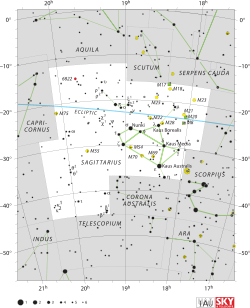Omega Sagittarii
From Wikipedia, the free encyclopedia

Location of ω Sagittarii (circled) | |
| Observation data Epoch J2000.0 Equinox J2000.0 (ICRS) | |
|---|---|
| Constellation | Sagittarius |
| Right ascension | 19h 55m 50.3577s[1] |
| Declination | −26° 17′ 58.223″[1] |
| Apparent magnitude (V) | 4.70[1] |
| Characteristics | |
| Spectral type | G5IV[1] |
| U−B color index | +0.32[2] |
| B−V color index | +0.75[2] |
| R−I color index | +0.37[2] |
| Astrometry | |
| Radial velocity (Rv) | −21.0 ± 0.9[1] km/s |
| Proper motion (μ) | RA: 203.96[1] mas/yr Dec.: 74.40[1] mas/yr |
| Parallax (π) | 42.03 ± 0.94[1] mas |
| Distance | 78 ± 2 ly (23.8 ± 0.5 pc) |
| Absolute magnitude (MV) | 2.82[3] |
| Details | |
| Radius | 1.1[4] R☉ |
| Temperature | 5400[5] K |
| Metallicity | [Fe/H] = 0.00[5] |
| Rotational velocity (v sin i) | 2[5] km/s |
| Age | 2.9 (2.8 to 3.0) × 109[5] years |
| Other designations | |
| Database references | |
| SIMBAD | data |
Omega Sagittarii (Omega Sgr, ω Sagittarii, ω Sgr) is a G-type subgiant star in the constellation of Sagittarius.[1] It has an apparent visual magnitude of approximately 4.70.
Name and etymology
- This star, together with :
- 60 Sgr, 62 Sgr and 59 Sgr, consisting the asterism Terebellum[6] According to the catalogue of stars in the Technical Memorandum 33-507 - A Reduced Star Catalog Containing 537 Named Stars, Terebellum was originally the title for four stars: ω Sgr as Terebellum I, 59 Sgr as Terebellum II, 60 Sgr as Terebellum III and 62 Sgr as Terebellum IV .[7]
- ν Sgr, ψ Sgr, τ Sgr, 60 Sgr and ζ Sgr were Al Udḥiyy, the Ostrich's Nest.[6]
- In Chinese, 狗國 (Gǒu Guó), meaning Dog Territory, refers to an asterism consisting of ω Sagittarii, 60 Sgr, 62 Sgr and 59 Sgr. Consequently, ω Sagittarii itself is known as 狗國一 (Gǒu Guó yī, English: the First Star of Dog Territory.)[8]
References
- ↑ 1.0 1.1 1.2 1.3 1.4 1.5 1.6 1.7 1.8 1.9 LTT 7872 -- High proper-motion Star, database entry, SIMBAD. Accessed on line November 19, 2009.
- ↑ 2.0 2.1 2.2 HR 7597, database entry, The Bright Star Catalogue, 5th Revised Ed. (Preliminary Version), D. Hoffleit and W. H. Warren, Jr., CDS ID V/50. Accessed on line November 19, 2009.
- ↑ From apparent magnitude and parallax.
- ↑ HD 188376, database entry, Catalog of Apparent Diameters and Absolute Radii of Stars (CADARS), 3rd edition, L. E. Pasinetti-Fracassini, L. Pastori, S. Covino, and A. Pozzi, CDS ID II/224. Accessed on line November 19, 2009.
- ↑ 5.0 5.1 5.2 5.3 HD 188376, database entry, The Geneva-Copenhagen Survey of Solar neighbourhood, J. Holmberg et al., 2007, CDS ID V/117A. Accessed on line November 19, 2009.
- ↑ 6.0 6.1 Allen, R. H. (1963). Star Names: Their Lore and Meaning (Reprint ed.). New York: Dover Publications Inc. p. 355. ISBN 0-486-21079-0. Retrieved 2012-09-04.
- ↑ Jack W. Rhoads - Technical Memorandum 33-507-A Reduced Star Catalog Containing 537 Named Stars, Jet Propulsion Laboratory, California Institute of Technology; November 15, 1971
- ↑ (Chinese) AEEA (Activities of Exhibition and Education in Astronomy) 天文教育資訊網 2006 年 7 月 2 日
| ||||||||||||||||||||||||||
This article is issued from Wikipedia. The text is available under the Creative Commons Attribution/Share Alike; additional terms may apply for the media files.